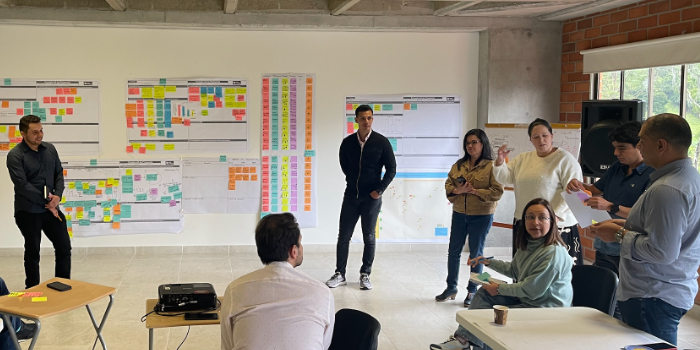
Aligning business areas to improve Time-to-Market
CASE STUDY – Following a positive experience in manufacturing, this Colombian company brought lean to the rest of the organization. Its goal? To become a reliable partner for its clients in the national and international markets.
Words: The Si3 Team with Héctor Rincón
SI3 is an industrial group specializing in the design of production processes using advanced quality-planning methodologies from the automotive sector. Our companies – SI Plásticos (Plastic Injection parts), SI Ensambles (foams, seats, and USB chargers assembly) and Colauto (metal parts and tooling fabrication) – differentiate themselves from their competitors through technology, competitiveness, and quality, as they strive to create value for customers with comprehensive solutions for the mass production of parts and components, emphasizing agility and versatility.
Our True North is to “turn projects into reality with high efficiency and quality in various technologies.” To reach it, a few years ago, we initiated a lean journey. This move followed a request by shareholders and began with a focus on our manufacturing activities. We wanted to make our companies efficient, with streamlined manufacturing processes, top-notch quality, and well-organized plants. Initially, we focused on applying a few lean tools in our manufacturing operations.
We quickly saw the benefits that lean could bring to our organization, both in process indicators and business profitability. This led us to reflect on how to progress further on the lean path. At the Lean Summit Colombia 2022, we were inspired to apply Lean Thinking beyond the plants and explore its potential for enhancing the overall business. After that, a business problem was identified as the catalyst for moving forward, prompting a shift in mindset: “Lean is not just a tool in the plant; it’s how we think and focus on business problems and customer needs.”
But how to translate this strategy into concrete actions?
With the intention of bringing lean to other areas of the business, we clearly defined our purpose and began to identify and study our business problems during workshops with Lean Institute Colombia.
WHAT WAS THE PROBLEM TO BE SOLVED?
At the beginning, we thought that we knew what the problem to be solved was, but we had no idea and we directly jumped to possible solutions. What we did know was that there was an underlying situation that was creating problems for the business. We were focusing on the how, but not on the what. That’s why understanding the problem – and falling in love with that problem-finding process – was so important for us.
Once we clearly defined our problem – we needed to diversify our client base and acquire new customers from new sectors to grow our margins – we were finally able to identify the gaps and prepare a business-wide A3, which we used to establish four areas on which to focus our action plan (our drivers):
- In terms of the quotation process, we had to achieve better lead-times to be able to compete nationally and globally.
- Financially, we had to improve the contribution of each project and become more efficient with costs and expenses.
- In sales, we had to increase our conversion rate for the offers we presented to our customers, with a focus on expanding our client network and on improving our information flow to become better at making decisions.
- Deploying our strategy to align objectives both vertically and across the organization.
WHAT GOALS WERE SET?
Commercially, a primary conversion goal was set, essentially beginning by separating the quotation from the sale and establishing the sales team's objectives to close deals. The team began by understanding what the need was to achieve these goals, including the number of weekly visits, resources, technological tools, etc.
These definitions led to quickly closing the deals that were pending. As part of the entire quotation and conversion plan, people were moved from the back office and execution to the front office, which was weak and eager to begin and better understand customer needs.
The favorable impact of this talent-balancing action within the organization prompted reflections in the management team to continue making changes and to align the strategy with a transformation in the culture.
From a financial perspective, the goal was to implement a comprehensive strategy for consolidating figures through a robust system. The aim was to begin explaining, using, displaying, and disseminating this system to leaders and teams, enabling them to make decisions with agility and certainty. We weren’t just looking to increase sales but also to reduce gaps through improved costs, efficiencies, and other actions that each process could take in daily and very short-term management.
Concerning month-end financial closures, the intention was to integrate financial analysis to decrease execution times, reprocessing, and inefficiencies in this activity. We wanted to provide relevant information to management early on, to facilitate solid decision making.
In the quotation process, we realized we needed quick and competitively priced quoting to obtain new customers without neglecting current ones. This work plan addressed the entire quotation flow, analyzing the current situation through a Value Stream Map (VSM) to identify where each task occurred, the waiting times involved and the waste and actual lead-time of the process. This affected Time to Market, which we needed to reduce.
This is how these cross-functional actions quickly led us to results. Looking at the people side of things was also crucial, as we strived to achieve a collaborative approach to the pursuit of our strategy. Not everyone in the business was clear on what the strategy was, what our business goals were, and what tools we were going to deploy to pave our way to improvement and engaging people.
WHAT EXPERIMENTS WERE RUN TO CLOSE THESE GAPS?
According to the defined work fronts, in the Sales Department, it was crucial to fine-tune the handling of data through digital artifacts that would provide information for tracking quotation requests, customer evolution, and the real-time status of their progress.
To achieve this, a funnel-shaped dashboard was designed for daily management and the detection of blockers in the flow of the bidding process.

At the same time, we ran an evaluation of the distribution of people, based on their functions, across front office, execution, and back office, which led – as mentioned above – to a new organization of certain positions with a high technical understanding to strengthen the sales teams and be able to cover both new clients and existing ones. This way, we managed to double the number of quotes delivered, improve their lead-time, and grow our offers to the international market and to new segments in the national market.
As part of this reevaluation, we also tasked a number of people to conduct an analysis of the application of A3 Thinking as a problem-solving tool, with the goal of identifying the root cause of problems and launch experiments that would help us close the gaps we experienced in the conversion of leads.
Another area of focus we identified was the flow of quotations, which was led correctly by the technical area and other actors – like Sales, Design, Purchasing, Finance, etc. – but experienced difficulties in providing quotes in a timely matter, according to customer expectations (we made solid proposals, but they were often late).
To tackle this, we deployed Value Stream Mapping to analysis the flow end-to-end and improve the process lead-time by boosting our agility without sacrificing the quality of our offers.
This analysis highlighted long delays (approximately 90% of the process time) and very low ratio of value-added activities (10%). This told us we had to deploy countermeasures and an action plan to improve our service levels. With the improvement proposed through our future-state VSM, we achieved different results. The main one was the reduction of the quotation lead-time from 16.4 to 6 days, putting SI3 at the same and sometimes at a higher level than its competitors.
But perhaps what had the biggest impact was an experiment to establish a collaborative work cell aimed at eliminating delays, integrating the sales area and its tracking artifacts, and making quick and timely decisions to achieve the target response level. This involved daily management and categorizing offers into three types: easy (experience is available), normal (executed according to technical knowledge), and complex (involving more sophisticated steps).
Additionally, a Value Stream Manager was assigned to the quotation value stream with very positive results (as an ongoing cross-functional experiment, subject to necessary adjustments). The focus was on quoting and selling, along with the link to production processes to ensure a link all the way to customer delivery.
The third working front was Finance and looking at the contribution of current and converted projects and how to create awareness within the company of the financial situation through clear, understandable figures. This included the provision of information, with the support of management, that enabled decisions on plant costs and expenses that could have a concrete impact on the companies’ results.
To achieve these objectives, a Power BI tool was developed for validation, consolidation, and real-time deployment of execution reports to leaders and decision makers. The focus was on short-term visibility, with the idea of presenting a Minimum Viable Product (MVP), led by finance, and validated and complemented by the needs of each company in the group. The aim was to achieve a tracking standard allowing them to adjust the performance of each leader and their teams to address the cost and expenses they generated when executing the work.
Additionally, we ran another VSM exercise with the accounting and finance teams, trying to reduce the lead-time of the month-closing process and achieve greater agility in the accounting release of month-end closures.
Finally, an action that encompasses all others is the deployment of our strategy towards people development through managerial actions, led by the Organizational Development department. We had a significant problem: the current strategy was built collaboratively but it wasn't clear to everyone. Not everyone understood what the ultimate goal of the business was. We addressed it through group sessions such as Building the Strategy Together. We identified the spaces that served to engage people with that purpose. Through a training plan, we began to permeate the different levels of the organization.
The next step was to impact all the teams and encourage them to think about the problems in their daily processes and how to contribute to the solution in order to achieve significant improvements, a substantial change, or implement deeper solutions with root cause analysis (in the process, we opened 92 A3s). These efforts were aligned with the shared common strategy.
That’s what led to the leaner mindset that exists in the organization today, and to our people’s increased awareness of the importance of continuous improvement. We could see that it is all about everyone asking themselves, “What problems can I solve?” to truly contribute to the fulfillment of the company strategy.
In conclusion, the greatest success has been breaking down silos and achieving cross-functional teamwork with weekly short-interval follow-ups on each defined driver. This was complemented by group meetings to collectively present progress on each front, facilitating the chaining and alignment of advancements in each of the ongoing strategic pillars.
THE RESULTS
We achieved benefits on all fronts. We could highlight:
- At a business level, we clearly identified the purpose and associated problems, enabling the setting of strategic objectives in different areas of the company with a common goal.
- We defined indicators that measure reality and ceased to have vanity metrics, especially in the quotation flow, which had excellent service tables and an excellent process in theory but that failed to win business in the expected volumes.
- We implemented experimental work through shared quotation cells or platforms, where we reduced reaction times, achieved quick agreements, decreased email volume, and reduced the time-to-market for quotations by 65%. The cross-functional team was empowered with a strategic focus, where each member had a clear direction and worked accordingly with daily monitoring.
- Financially, tools were provided to convey financial information more easily and develop team capabilities by sharing knowledge for timely and impactful decision-making, enabling the tracking of each company's management to appreciate the impact of decisions on contribution.
- In the accounting area, there was a 40% reduction in the time to make information available in month-end closures (PLT reduction) in a first stage, with the implementation of over 30 improvement actions and an ideal Value Stream Map (VSM) aiming for a total PLT improvement of 55%.
- Relevant and clear information in the commercial area (optimized information flow) to better understand our customers and their needs and refine the results of presented prospects, thus improving conversion.
- Balancing the necessary staff to strengthen the commercial area without increasing headcount, through the analysis of employees assigned to the front office, execution, and back office. This allowed the identification of internal technical competencies in customer service (technical contact with the client to understand their real needs) and their technical commercial offers.
- We deployed a broad and inclusive strategy, generating ideas to reach everyone’s True North initially and translating those ideas into problems to solve using A3 thinking, with direct team participation in solving them and closing the A3s.
- At a managerial level, an “article club” was created, which might turn into a “book club”, where every eight days, reflections were made on articles focused on creating value for the customer, developing teams, and applying concepts. Efforts are now underway to find value-added value streams for customers and strengthen behaviors through actions for process leaders.
SOME REFLECTIONS ON THE JOURNEY
We are happy with what we have already achieved, even though we are just at the beginning of our journey and know we’ll need to persevere through every challenge.
We have been developing the capabilities of our people, fostering discipline in achieving our objectives, encouraging them to consistently go the extra mile, especially in terms of figures.
Teams got together around the new working methods. The process of creating them was highly participatory and inclusive, involving joint construction of solutions and direct engagement from various organizational levels. The organization now naturally discusses problems, and this mindset has permeated the operational level.
Commitment was achieved without imposition, through consensus and conviction, ensuring that the improvements that have been made will be maintained over time. For example, we have introduced a simple but highly impactful initiative, whereby each time the company gets a new client through a submitted quotation, a bell is rung. This way, the members of the quotation cell are motivated, feeling that their teamwork directly contributes to the company results. It's worth noting that the bell rings more and more frequently, and there is room for further improvement.
Developing a lean mindset has become a vital need within the teams, and they are eager to continue and make further improvements to the processes. The teams talk in terms of indicators all the time and are maintaining the working structure we have designed.
Looking to the future, we plan to review the work of different areas to strengthen our decision-making and continue involving everyone in achieving good business results.
We intend to sustain and expand our daily management efforts until they become a routine, challenging ourselves to reach our objectives year after year and supporting different processes. We will also continue to support the deployment of our strategy to include all individuals working at SI3, reinforcing the implemented tools, especially A3 Thinking.
A significant challenge we’ll have to tackle is leadership – the core of the Lean Transformation Framework we are following – as we work hard to help them understand their role is to allow people to experiment, make mistakes and learn, not providing solutions. We are also working on defining our basic thinking (the floor of the LTF house), which we want to permeate the organization’s DNA.
The big question going forward is: how can we ensure that all of this change transcends individuals and endures in the organization?
THE AUTHORS
The Si3 team and Héctor Rincón, Project Manager at Lean Institute Colombia
Read more


FEATURE – Have you ever wondered how lean tools and principles might apply to writing? To inspire you to document your learnings, our editor offers a guide for aspiring writers in our community.


FEATURE – As 2020 finally draws to an end, our editor reflects on the year that was and discusses why the Lean Community is a such an important source of inspiration and hope.


FEATURE – Over the course of his career in the wind energy industry, the author has learned the power of horizontal integration in the improvement of organizations. In this piece, he shares his experience as a lean practitioner and leader at Ecotècnia.


FEATURE – The author shares his thoughts about the thinking that informs Uri Levine’s book and explains why this is perfectly align with a lean mindset.
Read more


INTERVIEW – As we look back at the evolution of lean management in our countries, the story of Instituto Lean Colombia will certainly sound more than familiar.


INTERVIEW – In this Q&A, we learn how the Technical & Production (T&P) area of Nestlé Colombia Ecuador is using lean and Art Smalley’s four types of problems framework to bring leadership closer to the gemba.

